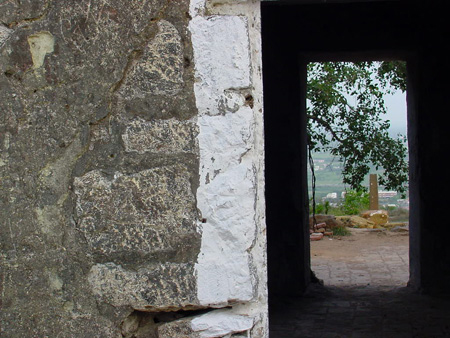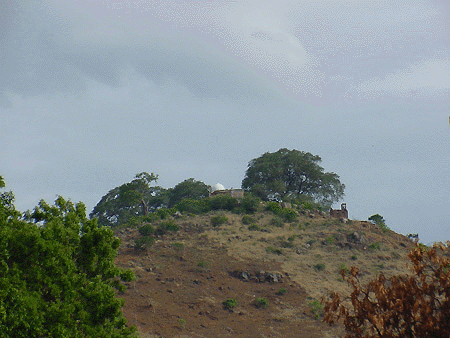
|
|
|
|
The Panchapandava Cave Temple was built on the southern slope of a hill, situated amongst the excavation hills (quarry areas) east of the present day settlement at Pallavaram. The site is one of a series of amazing rock-cut temples constructed by King Mahendravarman throughout his kingdom, others of which are found at Dalavanur, Tiruchirapalli, Mandagapattu, Kilmavilangai, Mamandur and Tiru-kazhukunram. The Panchapandava Temple was constructed in typical Pallava style, with six huge pillars in front. Cut into the mother rock was a sanctum sanctorum featuring five cells, one for each member of the Trimurti, the presiding deities. The two cells on the outer sides were for subsidiary deities, whose identity is unknown. All five shrines face south. The sanctum as a whole projects outward, carved from a protruding section of the main rock. In the picture below, we see that at one point, a roof covered the sanctum and a narrow porch area. As was typically the case with Mahendra rock-cut temples, the number of shrines correspond to the number of pillars, so that each niche would be approached by stepping between a pair of pillars.
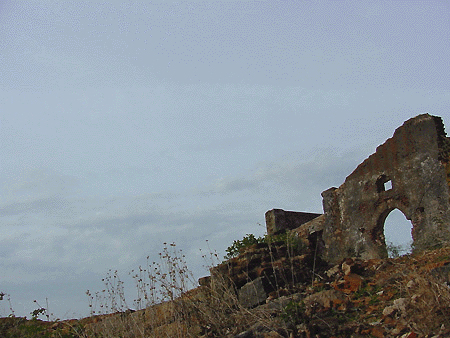
Panchapandava Temple Ruins
The style of construction of the Panchapandava Cave Temple clearly marks it as the work of Mahendravarman I, who departed from the typical style of the day, using building materials like brick, timber, metal and mortar. In an inscription found in the cave of Laksitayatana at Mandagappattu, the king declares that he caused the construction of the temple for Siva, Visnu and Brahma without the use of conventional building materials, indicating his introduction of this new style of architecture – rock-cut cave temples. In fact, many of the cave temples built by Mahendravarman were dedicated to the Trimurti as presiding deities, and each of the divine personalities was given an independent shrine, or niche in the rock-cut temple. These garbha-grihas were empty in almost all cases. They did not contain either a rock-cut linga or linga-pitha, or any other deity form, as was commonly done in the Pandya, Muttaraiyar and Chalukyan cave-temples.
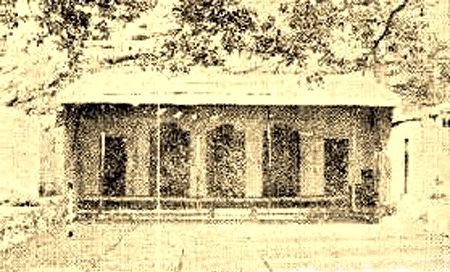
Panchapandava Cave Temple So it is not that the Deities of Panchapandava Cave Temple were lost, moved or destroyed by invaders, but rather the cave shrines themselves were considered to embody the Deities. For that reason, regardless of the fact that Muslims have now taken the cave temple over, this holy site must still be considered a place dedicated to the worship of Lord Brahma, Shiva and Visnu. In the absence of murtis or other sculptures in these rock-cut temples, traces of lime and plaster are often found, these having been the base upon which paintings were done. These were typically painted onto the back walls of the garbha-griha niches, and depicted the personality to whom the shrine was dedicated. Occasionally, the slight relief of a pedestal cut into the base of the rear wall is found, further indicating that the deity was depicted in stucco, or lime mortar and paint. In some cases, a wooden panel with a carving may have been set into a niche in the wall. Many such figural representations likely came and went over the centuries following construction of the rock-cut temples. The Mahendra temples are further recognizable by the absence of other kinds of sculptural ornamentation, even in the mandapa, except for the dvarapalas. And in the case of the Pallavaram temple, being one of the earliest sites, there are no dvarapalas present. Even the lotus medallions usually carved into the top and bottom of the pillars are not found at Pallavaram. We should also note that among the many fine examples of rock-cut temples constructed by Mahendra in the area, those at Mamallapuram (Mahabalipuram) are perhaps the most famous. One in particular – the Panchpandava Mandapam – is often confused with the Panchapandava Cave Temple featured in today's segment. The example at Mamallapuram includes an unfinished monument with pillars adorned with lions, and references to these pillars cause some confuse between the two rock-cut sites.
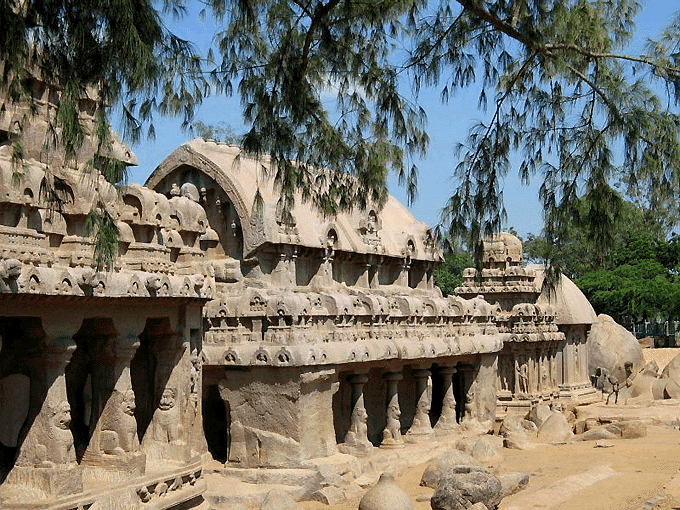
Mamallapuram Rock-cut Temple As evidenced by the number of Trimurti temples built by Mahendravarman, the king clearly had religious sentiments in Their direction. However, scholars say that he also developed great affection for the Jains, and their influence may have caused Mahendra to give up the warlike attitude typical of the Pallava and Chola monarchs he followed, including his father Simhavishnu, the great warrior who subdued all the kingdoms of the south and Srilanka. Although a great patron of Jainism, Mahendravarman eventually converted back to Vedism, under the influence of the saint Appar. Appar was well known for targeting those who had been converted by the Jains, bringing them back to the Vedic fold. So again, we see an interesting convergence of religions in the story of this temple. After converting back, Mahendra went on to make great contributions to Sanskrit forms of dramatic dance, particularly Kutiyattam. He wrote many Sanskrit dramas based on the Ramayana, Mahabharatha and Puranas. He is also credited with the invention of the seven-stringed Veena, known as the parivadhini. To the Vaisnavas and Saivites, the hill at Panchapandava Cave Temple is known as Panchapandava Malai. To the Muslims who have taken it over, it is known as Maula Ka Pahad. Muslims believe that Pallavaram Hill is home to a relic of Prophet Mohammad. In the evening during Ramadan (called Ramzan in India), Muslim pilgrims walk to the top of the hill where the cave temple ruins are found.
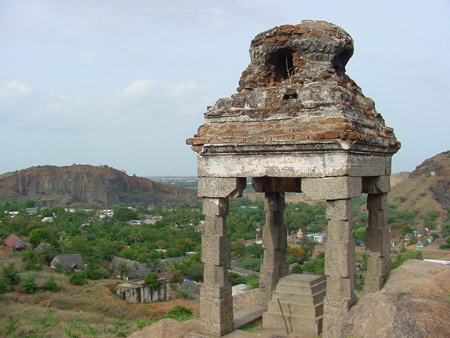
In fact, it was originally the Sufi Muslims who invaded this area, taking over the Panchapandava caves and turning them into a masjid for worshipping the panjã (palm). While now being used as a Muslim dargah, the temple ruins have unfortunately been painted and renovated beyond recognition. Even the temple inscriptions have been obliterated. Part of the temple cave has been closed off with mud walls. One can only wonder how it is that the government of India and the ASI permit such desecration of Vedic holy sites to go on. When not being used as a dargah, or place of worship, the Muslims use the site for commercial purposes, giving access for a fee to producers filming Tamil style Bollywood movies. Such is the fate of Lord Brahma's abode at Pallavaram in Kali-yuga.
| |
